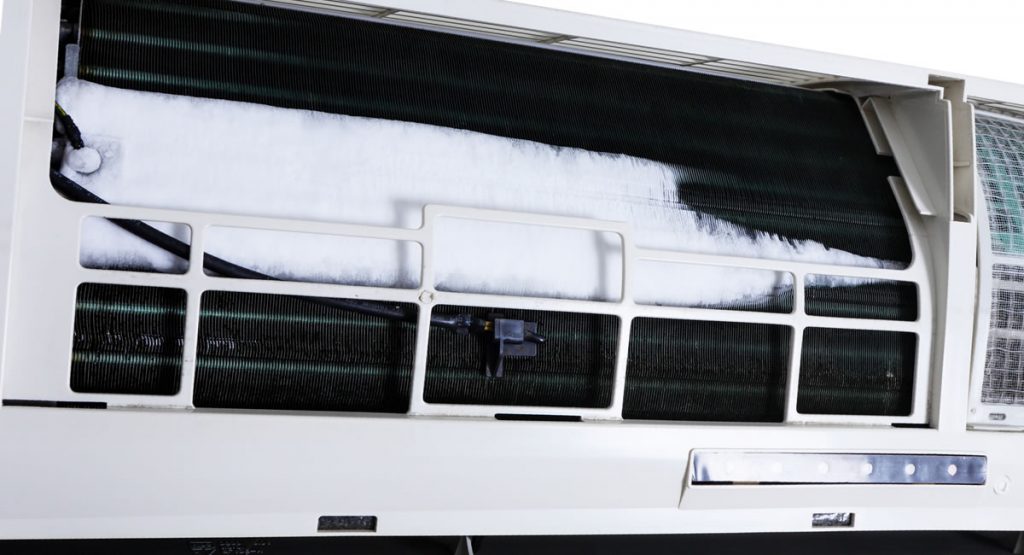How to Manage a Frozen AC Pipe: Specialist Advice
How to Manage a Frozen AC Pipe: Specialist Advice
Blog Article
We've come across this post pertaining to Why Is Ice On My Outside Air Conditione listed below on the internet and decided it made good sense to discuss it with you here.

Introduction
Uncovering that your air conditioning pipe is frozen can be worrying, particularly throughout warm summer months when you rely upon your air conditioner one of the most. Understanding what to do in such a circumstance is vital to prevent additional damages to your cooling system and guarantee your convenience indoors.
Comprehending the Causes
Numerous factors can contribute to the freezing of an a/c pipeline. Understanding these causes can assist you attend to the concern properly.
Absence of Airflow
One typical source of an icy air conditioner pipe is inadequate air movement. When the airflow over the evaporator coil is limited, it can cause the coil to go down below freezing temperature level, causing ice development on the pipe.
Reduced Refrigerant Levels
Not enough cooling agent levels in your a/c system can additionally lead to an icy pipe. Reduced refrigerant levels can create the pressure in the system to drop, leading to the cold of wetness on the evaporator coil.
Cold Weather Conditions
In cooler climates, freezing temperature levels outside can contribute to the cold of air conditioner pipes. If your air conditioner system is not appropriately insulated or if there are leakages in the ductwork, cold air can infiltrate the system, creating the pipe to ice up.
Dirty Air Filters
Unclean or blocked air filters can limit air flow in your air conditioner system, leading to different concerns, consisting of a frozen pipe. It's vital to replace or cleanse your air filterings system consistently to guarantee appropriate air flow and protect against ice build-up.
Indicators of a Frozen AC Pipe
Acknowledging the indications of a frozen AC pipe is important for timely activity.
Lowered Airflow
If you see a significant reduction in air movement from your vents, it can suggest a frozen pipeline.
Ice Buildup on the Pipe
Visible ice build-up on the refrigerant line or the evaporator coil is a clear sign of an icy air conditioner pipeline.
Strange Sounds from the Unit
Uncommon audios, such as hissing or gurgling, originating from your a/c unit can signal that there's ice existing on the pipeline.
Immediate Actions to Take
When faced with a frozen AC pipe, it's important to act rapidly to prevent additional damages to your cooling system.
Switching off the AC
The first step is to shut off your ac system to prevent the system from running and aggravating the problem.
Looking for Blockages
Inspect the area around the interior unit for any type of obstructions that might be blocking airflow, such as furniture or curtains.
Defrosting the Pipe
You can utilize gentle methods like placing towels taken in cozy water around the frozen pipe to help thaw it gradually.
Preventive Measures
Taking safety nets can help stay clear of future events of an icy a/c pipe.
Normal Maintenance Checks
Set up routine maintenance consult an expert HVAC service technician to guarantee that your air conditioner system is running effectively.
Altering Air Filters
Consistently change or cleanse your air filters to stop air flow limitations and preserve optimum efficiency.
Protecting Exposed Pipes
If your a/c pipes are exposed to chilly temperature levels, think about protecting them to stop cold during winter season.
Seeking Professional Help
If DIY approaches fail to solve the concern or if you're unsure about how to proceed, it's best to seek assistance from a qualified HVAC technician.
When DIY Methods Fail
If your attempts to thaw the pipeline or address various other concerns are not successful, it's time to call a specialist.
Importance of Hiring a Professional HVAC Technician
A qualified HVAC professional has the proficiency and devices essential to identify and repair concerns with your a/c system safely and efficiently.
Verdict
Managing an icy AC pipe can be an aggravating experience, however understanding exactly how to respond can help lessen damage and bring back comfort to your home. By understanding the reasons, acknowledging the indications, and taking prompt action, you can effectively address the issue and prevent future incidents.
What to Do If Your AC Line Is Frozen
Make Sure All Supply and Return Air Vents Are Open
If you notice problems with airflow, the first thing you should do is check your supply and return vents. Supply vents distribute clean, conditioned air throughout your home. As this air becomes stale, it’s pulled into the return vent, where it’s reconditioned before being sent back out through the supply vent.
When these vents are closed, air won’t flow in the home. Before examining your AC, check the vents in every room and ensure they’re all open.
Check for a Dirty Air Filter
Another possible cause of limited airflow is a dirty air filter. Your air conditioner’s filters catch elements you don’t want to breathe in, such as dirt and dust. Over time, filters can become clogged, ultimately blocking air from flowing in and out. The lack of airflow can then cause the entire coil to freeze and will completely restrict any air from moving through it. The AC may need to be powered off for one to two days to allow the coil to thaw after replacing the filter to allow proper functioning of the unit. This debris can also accumulate on your AC’s evaporator coil, requiring a more serious repair. In general, air filters should be cleaned regularly (about every two weeks).
Assess Your Outdoor Unit
In addition to checking your AC, assessing the outdoor unit is a good idea. Also known as the condensing unit, it works with your interior unit to release heat outside. An issue with the outdoor unit can result in rising internal temperatures.
Overgrown Shrubs or Clogged Leaves
From leaves and twigs to shrubs and debris, there’s no shortage of outdoor elements that can accumulate around your condensing unit. When these elements get lodged inside the unit, they can block airflow. Fortunately, removing the blockage can solve the problem.
Sounds of a Broken Fan
Shrubs and leaves aren’t the only things that can impede your outdoor unit’s airflow. If the fan is broken, the unit won’t be able to properly get rid of heat — which means the internal temperature won’t go down. First, make sure the fan is spinning. If it is, check for the following sounds of a broken fan:
Buzzing Rattling Screeching Hissing Clicking Preventative Measures
Nobody wants to deal with a frozen AC line. In addition to causing problems with your air conditioner, they require professional repairs. On the bright side, there are preventative measures you can take to help ensure this issue doesn’t arise in the first place.
https://www.coopergreenteam.com/blog/what-to-do-if-ac-line-frozen

I was made aware of that editorial about How can I fix an air conditioner’s frozen pipe? from an associate on our other website. Enjoyed reading our blog entry? Please share it. Help other people locate it. Bless you for your time. Come back soon.
Call Today Report this page